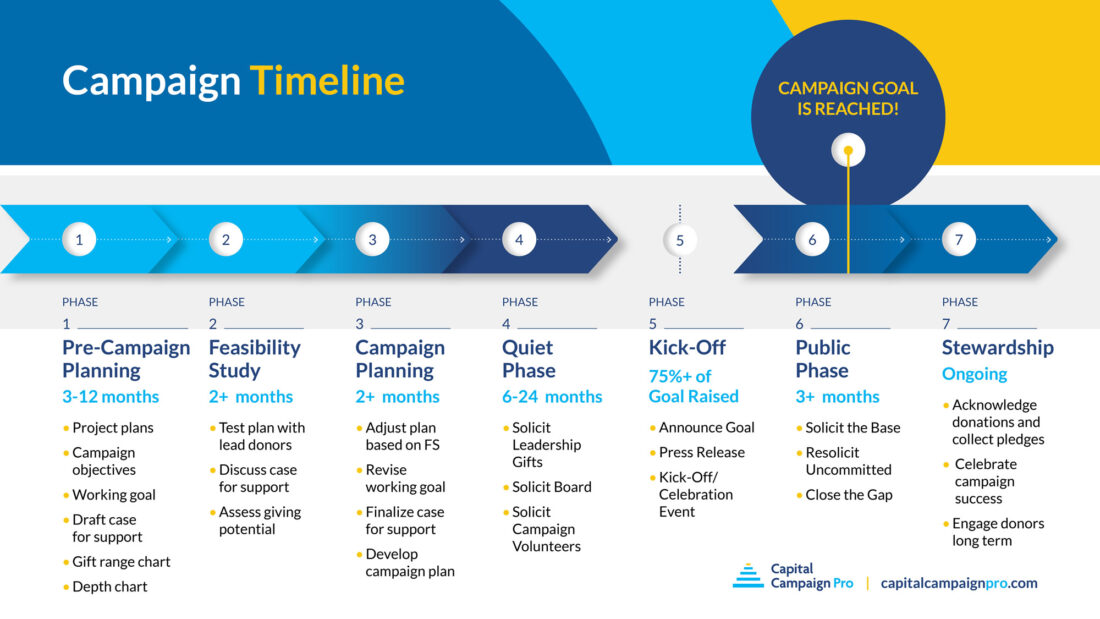The Capital Campaign Quiet Phase: What to Know to Succeed

Capital campaigns are ambitious ventures, and looking at the whole campaign at once can make it feel overwhelming. However, the campaign immediately begins to feel more doable when you think about it one phase at a time.
If you are embarking on a capital campaign, you’ll divide your work into seven key phases. The largest of these is the Quiet Phase. This critical time can set the tone for the rest of your campaign and strengthen your relationships with major donors in several ways.
In this guide, you’ll learn about the power and importance of the Quiet Phase, as well as how to succeed with one of your own:
- The Quiet Phase: An Overview
- The Capital Campaign Timeline: Where the Quiet Phase Fits
- 3 Capital Campaign Quiet Phase Strategies for Success
- Tools to Keep Your Campaign on Track From the Quiet Phase and Beyond
Once you know how this phase works and how to approach it effectively, you’ll be ready to raise the lion’s share of your goal during the Quiet Phase of your own campaign.
Get Your Campaign Questions Answered
Join our community for these monthly town-hall style discussions and get answers to your most burning questions in real time.
The Quiet Phase: An Overview
What is the Quiet Phase?
The Quiet Phase, sometimes called the silent phase or quiet period, is the fourth phase of a capital campaign (more on this below). It’s the initial and most critical fundraising portion of the campaign. During this phase, you work behind the scenes to secure the largest gifts from lead donors.
Many people misconstrue the meaning of the term. They think that during this phase of the campaign, they shouldn’t be discussing it at all or that fundraising is happening in secret. However, that is not the point.
During the Quiet Phase of your campaign, you will talk to your largest potential donors one-on-one and secure as many of the largest gifts as possible. Your success in securing those gifts will determine how much money your campaign can ultimately raise.
Toward the end of the Quiet Phase, you will revisit your campaign goal. If you’ve done better with the lead gifts than you imagined, you might increase the goal. If you’ve struggled, you might decrease it.
So, during the Quiet Phase, while you talk to key donors and other stakeholders about the campaign, you don’t publicize the campaign goal. That is where the name comes from. However, you can (and probably will) talk publicly about the project and vision for the campaign without sharing goal specifics.
What Takes Place During the Quiet Phase
“Raising the largest gifts from lead donors” is a good shorthand for remembering the central goal of the Quiet Phase, but there is more to it than that. The Quiet Phase involves several other tasks, including:
- Identifying and engaging major donors. During this time, you’ll build relationships with individuals and organizations that have the potential to make transformational gifts to your campaign, sharing your preliminary campaign plans with them and seeking to know how they’d like to be involved.
- Preparing campaign materials. Develop tailored proposals and presentation materials for individual donors. Toward the end of the quiet phase, you may also start preparing materials you’ve already created and tested, like your case for support, to be shared with your broader donor base.
- Soliciting lead gifts from lead donors. When the timing is right, you’ll secure commitments from your largest donors (typically the first 20 people on your gift chart), your board members, and campaign committee volunteers to establish momentum for the campaign. These solicitations will be extremely personalized to each donor, their values, and their interest in your mission and campaign.
- Refining the campaign goal. Based on initial feedback on and lead gift commitments, adjust your campaign’s working goal. Remember to be ambitious yet realistic.
- Building internal support. This is also the point in the campaign where you’ll want to ensure 100% participation and investment from your board and other key stakeholders. Their support will be crucial as the campaign moves forward.
Who Is Involved in the Quiet Phase
Several key players need to be involved in order for your campaign’s Quiet Phase to succeed. Here is who should be involved and what they’ll be responsible for:
- Board members, who will act as ambassadors for your campaign, serve as lead donors themselves, and help you fundraise
- Your fundraising team, who will coordinate solicitations and manage donor relationships
- Campaign consultants, should you choose to hire them (the alternative is taking a DIY approach), who will provide capital campaign expertise and strategic advice to keep you on track to raise lead gifts
- Major donors, who will serve as the backbone of your campaign, often contributing up to 75% of your goal
- Key staff members, who will handle quiet phase planning, logistics, and follow-up efforts
The Capital Campaign Timeline: Where the Quiet Phase Fits
The Quiet Phase is the fourth phase in most capital campaigns. Here’s where it fits in:

As you can see, the Quiet Phase is preceded by:
- Pre-Campaign Planning, during which you clarify your objectives, develop a preliminary or working goal for your campaign, draft the case for support, and create your gift range and depth charts.
- Feasibility Study, during which you test your preliminary plan with your largest donors, discuss your case for support, and assess individuals’ giving potential.
- Campaign Planning, during which you actually develop a plan for your campaign based on feedback from the feasibility study, revise your working goal, finalize your case for support, and develop the timeline, policies, and donor recognition plans for the campaign.
Following the Quiet Phase, you’ll transition to the fifth phase, which is the Campaign Kick-Off. This is when you publicly announce your goal and begin the process of soliciting mid-level and smaller gifts. Many organizations like to hold some sort of celebration or event to mark the Kick-Off.
How Long the Quiet Phase Lasts
The Quiet Phase is typically the longest phase of a capital campaign, lasting anywhere from six to 24 months until you secure 65-80% of your goal.
Though the number of gifts solicited during this phase may be relatively few, they will be the largest gifts to the campaign. And soliciting such large gifts will take time.
3 Capital Campaign Quiet Phase Strategies for Success
To ensure your Quiet Phase goes smoothly and you raise as much of your fundraising goal as you can, employ these tactics:
1. Solicit feedback from key supporters.
Soliciting the largest gifts for a campaign is often more akin to donor cultivation and engagement than a simple, one-and-done ask. The largest donors to your campaign are really partners in the project, and their willingness to invest their money in the project will depend in some part on how involved they are.
In most cases, you will have engaged them in the earlier phases of the campaign. But even when you get to the Quiet Phase and are ready to solicit them, you may find many opportunities to engage them.
Here are just a few of the ways you might involve your largest donors:
- Invite them to serve on a lead gift committee.
- Ask them to review a proposal you’re working on.
- Ask them to make a call to connect you to another donor.
- Ask them to host an event at their home for a few other donors.
- Ask for advice about how to solicit other donors.
- Invite them to join you for a solicitation.
Some donors, and foundations in particular, may not want to play an active role in your campaign. However, even for foundations, you should be in touch with your program officers to ask them for advice long before you submit a proposal. That, too, is a form of engagement.
2. Develop a strong strategy for making the ask.
When soliciting the largest gifts, you’ve got to remember that each solicitation should be tailored to appeal to the interests and giving patterns of the particular donor.
The easiest and most accurate way of determining a donor’s interests is by looking at how that donor has given in the past. Ask yourself: What has this donor given to, and what size gifts have they given before?
While you can do extensive research to learn about donors (and prospect research certainly has its place), we’ve found that there are few things more effective than a lively curiosity about people. If you ask them about themselves, they are likely to tell you a great deal about:
- Why they give
- Where their money came from
- Why they give to certain causes
- What makes them excited about a given project
Of course, getting to know your donors takes time. It’s time worth spending.
If you don’t have any idea why a major donor would want to give to your campaign, you’re not yet ready to ask that person for a gift. Don’t short-circuit the process in your rush to complete the solicitations. Your campaign will suffer if you do.
Free Campaign Checklist & Guide
Download our free capital campaign checklist and guide to learn exactly what’s required for each phase of your campaign.
3. Don’t rush.
The end of the Quiet Phase is marked by your Campaign Kick-Off. Here are seven items you should complete before you kick off the Public Phase of your campaign:
Assess progress toward the campaign goal.
Before kicking off your campaign, you should have raised a minimum of 65% of the campaign goal. For smaller organizations and campaigns, having closer to 75% or even 80% is advisable. You should have solicited most, if not all, the lead gifts for your campaign. And every board member should have made a gift.
Revise the campaign timetable as needed.
This is a good opportunity to step back and revisit your campaign timeline. Are things on track? Do you need to prepare for a longer campaign, or can you wrap up it more quickly than anticipated?
Determine the goal to be shared.
During the Quiet Phase of your campaign, you’ve been using a “working goal.” Now is the final opportunity to adjust the goal up or down before publicly announcing the official campaign goal.
Determine mid-level solicitation teams and enlist leaders for each team.
The Public Phase is when you’ll need to rely on many volunteers to help solicit mid-level gifts for your campaign. It’s time to enlist team leaders and provide training for those teams.
Complete your campaign brochure and develop a webpage for the Public Phase.
As you approach the Public Phase of your campaign and you have a firm goal, you’ll want to create a campaign brochure and a web presence to give your campaign volunteers confidence as they go out to solicit gifts.
You may be surprised to learn that the largest solicitations in the Quiet Phase are usually made without campaign brochures. Instead, you will develop simple materials for each solicitation fine-tuned to appeal to that donor’s interests.
Plan the Campaign Kick-Off.
A Campaign Kick-Off or celebration will officially launch the Public Phase of your campaign. And that event must be planned during the final months of the Quiet Phase.
Kick-Off events vary in scale and scope, from a small groundbreaking with punch and cookies to something much more elaborate and formal, depending on the organization’s style and the donors’ expectations.
Secure a challenge gift to announce at the Kick-Off.
A challenge gift is a wonderful tool for raising money towards the end of your capital campaign. Many donors feel motivated to give when they know their gift will be matched, and some enjoy leveraging their gifts in that way.
So, if you can, try to secure a significant challenge gift that you can announce at the Kick-Off event to create excitement for the Public Phase.
Tools to Keep Your Campaign on Track From the Quiet Phase and Beyond
In general, you’ll need to develop the following to help keep your Quiet Phase organized and on track to help you raise the majority of your campaign goal:
- A case for support that clearly articulates the “why” behind your campaign
- A gift range chart that maps out the number and size of gifts needed to reach your goal
- A depth chart that tracks solicitation progress and identifies gaps in your donor pipeline
- Donor management software that streamlines communication and makes it easy to track donor touchpoints
How Capital Campaign Pro Can Help
Capital Campaign Pro offers expert resources, templates, and personalized support to help you stay on track and achieve your capital campaign fundraising goals.
Schedule a free strategy session today to explore how we can support your campaign!
Want to keep learning about the world of capital campaigns? Check out these additional resources:
- Capital Campaign Plan: 11 Essential Elements & Top Tips
- Starting a Capital Campaign: A How-to Guide for Nonprofits
- The State of Capital Campaigns Benchmark Report 2024-25
Get the support you need to succeed.
With our approach, you get the support, expertise, and guidance you need — plus all the tools and materials — to make your campaign a success.



Great article. Thanks for sharing. Would like to share with my supervisor.
Thanks Paula. Happy to have you share it with your supervisor. It’s great when pieces like this can help people in positions of responsibility understand how campaigns function.
You are perfectly positioned to lead an important change regarding misunderstanding of the Quiet Phase. Please, just stop calling it that. If non development people are confused by it, it falls to us development people to make it less confusing. In general, we development people are awful at nomenclature. This would be an easy, customer/donor-focused change. Thanks for coming to my TED Talk.
How about calling it the “Strategic Partner Phase?”
What would you suggest, Dan? Thx for your comment. Of course, you are right. We development people should change the language. Here are some other phrases I’d like to change —
Capital Campaigns should really be Capacity Campaigns
Feasibility Studies should be Campaign Planning Studies
And then there’s “The Ask” which I’ve always hated. Makes it sound like a dreaded disease instead of a warm and friendly conversation.
And how about “Kick-Off”? Perhaps that should be the “Nearly There Celebration”
I feel a new blog post in the making. 😉
Nomenclature suggestions.
Quiet phase to Engagement Build
Capital campaign to Capacity Build
Feasibility Study to Opportunity Analysis
The Ask to The Request(real & respectful)
Kick Off to The Reveal
These are great suggestions. Thanks so much, Jay! I particularly love “The Reveal”!